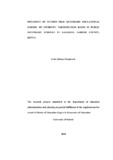| dc.description.abstract | The purpose of study was to investigate the influence of tuition free secondary educational subsidy on students’ participation rates in secondary schools in Kasarani Sub County, Nairobi County, Kenya. The study aimed at achieving the following objectives; to determine the influence of tuition free secondary education subsidy on equity in students’ enrollment, dropout rates, retention rates, and completion rates in public secondary education. The study was based on Human capital theory developed by Schultz in 1971. The study adopted descriptive survey design method. The study targeted all the 18 schools in the Sub County, 18 principals from the schools, twenty-six class teachers and one thousand one hundred and thirty-eight form three students. Ten are mixed public secondary school and were purposively selected for this study. Ten Principals from the schools and twenty-six class teachers were also purposively selected for the study from the Sub County. The sample size of 30 percent of the students’ population out of 1138 students from form 3 were targeted for the study, 700 were boys while 438 were girls. The sample therefore included 210 boys and 131 girls. Simple random sampling was then done in each school visited. Questionnaires were used to gather information from the teachers and students while interview schedule was used to collect data from the Principals. Piloting of the instruments was done in one school which did not participate in the study. Content validity were undertaken to ascertain the content to the questionnaires. The researcher visited the schools and introduced herself to the Principals and booked appointment for data collection. A correlation coefficient of 0.74, 0.78, and 0.71 was obtained from the questionnaire for principals, teachers and students respectively, which showed that the instruments were highly reliable. Collected data were analyzed both qualitatively and quantitatively and results presented in frequency distribution tables and interpreted to answer on the study objective. The findings of the study were intended to benefit the government to adequately subsidize secondary education as well as the ministry of education in ensuring equity in distribution of educational resources. The findings were presented using frequency distribution tables. The results showed that effective and efficient utilization of tuition free subsidy led to increased equity in enrollment rates of students in secondary education as reported by 57 percent of the principals. It was established that tuition free secondary education subsidy reduced students’ dropout rates as was revealed by 60 percent of the teachers. The study revealed that tuition free secondary education subsidy increased students’ retention rates indicated by reduced repetition rates. The study established that the subsidy was very effective in increasing completion rates as reported by 71.4 percent of the principals. The study recommended that the subsidy be increased to cover levies for lunch and school uniforms and should be disbursed on time. Finally, the study concluded that tuition free secondary education subsidy played a very important role in increasing students’ participation rates in secondary education | en_US |



